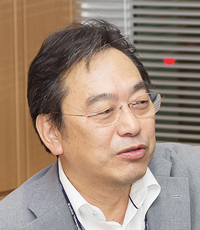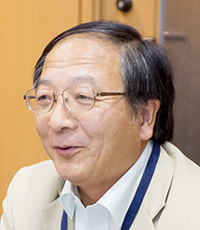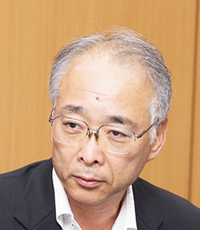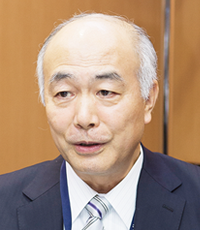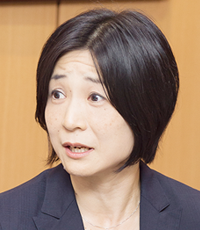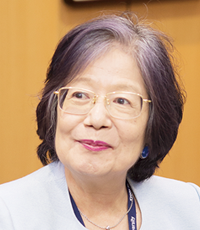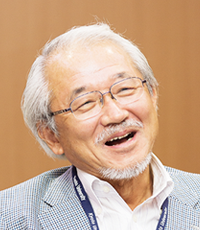Masao Suzuki (Chiba Prefectural Chiba High School): It has been a prefectural school since its establishment, and this year marks the 138th year.There are older schools from the time of the clan school, but they are the oldest in the prefecture.Although criticized, he continues to say that he will not take classes for college entrance exams.Eight years ago, the prefectural board of education established the attached Chiba Junior High School and became a junior high and high school integrated education school.80 students in 240 classes in junior high school and 1 students in 320 classes in high school will be enrolled to 80 students in the first grade.In junior high school, even if you step into the contents of high school to some extent, you do not take the lead in the curriculum and learn the contents of junior high school deeply and widely.In high school, 10 intern students are divided into XNUMX classes of XNUMX each.Junior high and high school students have graduated from the second term so far.The track record is almost the same as that of foreign students.
Last year, we asked Kyoto University for an on-site lesson by graduate students, and this year we also asked for it in October.Even in junior high school, we are calling various people as a lecture for working adults, but this year we invited Yuta Shintaku, a curator of the Faculty of Science of the Japan Monkey Center, who advanced from our school to Kyoto University.
One of the worries is that the students are not as strong as Urawa High School.There are a certain number of students who are unable to attend school due to family or mental problems, and there are a few more students who cannot reach their position, although they cannot reach that level.I think that if we overcome that, we will be able to grow stronger, so I hope that a more optimistic atmosphere will spread throughout the school.
Regarding the special entrance examination, I would be grateful if the Chiba High Nobel Prize * XNUMX etc. could be evaluated.
Masato Tayama (Chiba Prefectural Funabashi High School): This year marks the 95th year, but there are 31 older schools in the prefecture.However, it is older in urban areas near Tokyo.Currently, I am enthusiastic about how to improve the yield while the examinees are leaving for private schools in Tokyo and integrated middle and high schools in Tokyo.Although the ratio is high in the prefecture, there are still challenges in raising the students who have entered the school.
It is the same as many schools attending here that they emphasize experience and are enthusiastic about events to raise students who are physically and mentally strong.The club activity participation rate is also high.However, some children are mentally vulnerable.
Two people have been designated as SSH and went out to the world at the Biology Olympiad.I went to the University of Tokyo, but there is one student who is particularly sharp like this every few years.On the other hand, when looking at research projects, some students have interesting ideas, although they are not so sharp.Only such students are enthusiastic about artistic activities and join many circles.It's still a long way to go, but I'm thinking of raising strong students who have acquired a wide range of comprehensive academic abilities, so I'd appreciate it if you could train at university.
Hiroaki Tokinori (Kanagawa Prefectural Shonan High School): Opened as the sixth prefectural junior high school in Kanagawa, and this year is 95.There are many celebrities, including Professor Eiichi Negishi, who won the Nobel Prize in Chemistry.
Like many schools that gather here, we are putting out education for all, such as creating people through school events.Recently, in Kanagawa prefectural schools, club activities are being reduced or restricted, and the number of places to shift to management-type examination education is increasing, but since the school opened, the idea that education for examinations is not provided is thorough. I'm letting you.Also, in order to acquire a wide range of education, unlike many schools in Kanagawa, we do not divide the humanities in two years, but all learn the same subject in the first and second years, and classify in the second to third years. do not.Even in high school XNUMX, students who want to study liberal arts and science are mixed in the same class, and the topics of both are mixed.As for the career path, many students find a specialty while studying at a university without narrowing down to a detailed specialty.I want to raise students who can do their best after entering university.
Akira Yoshino (Ohyu Gakuen Girls' High School): This is the 80th year of Ohyu Gakuen, but it is a school established by the alumni association of Tokyo Prefectural Daiichi High School for Girls (currently Tokyo Metropolitan Shirasagi High School), and the principals of both schools, Gen Ichikawa. There is a tradition of more than 100 years in the history of the third education.
His slogan is to fly to the world beyond his own frame, school frame, and Japan frame.As President Yamagiwa said, classrooms are not limited to schools, and even though they are girls' schools, they strongly say that they can learn anywhere if they want to learn.Some of the students go not only to Tokyo but also to Aichi boys' schools and this year's Tokyo Metropolitan Nishi High School to study, and going on to Kyoto University is also in view in this context.
According to the questionnaire about going on to university, more than 80% of the students choose the academic discipline or teacher they want to do, so it will have a big impact if the university teachers enthusiastically talk about the attractiveness of academic discipline.On top of that, female students also like the one-on-one correspondence.It seems that about 13% of students from the Kanto region go on to Kyoto University so far, which is still less than Tohoku University and Hokkaido University.In order to create further diversity, I would like you to strengthen your efforts nationwide, especially in the Kanto and Tokyo regions.
Shino Takenashi (Toshimaoka Girls'Academy High School): It's been 123 years since we started from the girls' sewing vocational school.Even now, all the students are moving hands for XNUMX minutes every morning.Even now that many girls' junior and senior high schools have stopped accepting from high school, our school still has two classes left.Not all students enter the school with the first choice, so I start by giving myself confidence.If you don't have confidence, you can't take on the challenge, and by extension, the realization of a society where women shine is far away.There will be various challenges when you go out into society, so I want you to take on the challenge of expanding your potential with confidence between high school and university.
This Saturday's Future Lecture will be attended by Professor Tetsuro Matsuzawa of the Primate Research Institute, Kyoto University.A graduate who entered Kyoto University directly asked the teacher to give a lecture at his alma mater.
Haruko Kazama (Joshigakuin High School): Our school was founded 50 years ago and is the oldest school we have gathered today.However, each successive principal (principal) has a long term, and I am still the XNUMXth generation.There are many graduates who have been active both in Japan and overseas since the foundation, but in recent years, generally speaking, there are few girls in Tokyo who want to go to a university outside the metropolitan area.I think it's okay to go to Kyoto and have the flowers bloom, but now that the students have very strong connections with their parents, how to persuade them is a challenge.I spent nearly XNUMX years at ICU (International Christian University), and Joshigakuin was very free when I was in school, so when I was young, I told him to cherish freedom and make mistakes.There is much to be gained by failing.I think Kyoto University is a university that allows failure, so I would like to emphasize that point as well.I think that freedom that is aware of responsibility is what nurtures humans.
Yukio Yanagisawa (Kaisei Gakuen Kaisei High School): This year is the 144th anniversary.The founder is Ding Sano * 18.After that, Korekiyo Takahashi succeeded and became the first principal, and the shape of the school was adjusted.I am the XNUMXth principal and it is my XNUMXth year.
There are 300 students in the first grade at junior high school.There are 400 students in high school and 2100 students in all schools.The course is really diverse, and the result can only be understood by the principal opening the lid. For 10 years, many teachers will be lifted as they are, so the colors will be different for each grade. It feels like there are six independent countries.What they have in common is that students find it fun to go to school.The same questionnaire as the national simultaneous academic ability test of middle 20 will be conducted for all from middle 96 to high XNUMX in June and October, but in June XNUMX of this year, there is no one who is "not fun". Since there were two people who said, "It's not fun," it can be said that most of the students come to school with fun like playing.This tendency does not change up to high XNUMX, and negative answers are less than a few in each grade.When you reach high XNUMX, you will be studying for entrance exams after the athletic meet, and there will be more than XNUMX people each saying "not fun" or "not fun".However, it is still less than XNUMX%, and overall, more than XNUMX% think that it is fun to come to school.
For that purpose, we have various ideas.One is club activities.There are a large number of 70, including athletic and cultural groups, including clubs.The average number of members in one department is 30, which is the size of a university seminar and is a group of like-minded people.This is a comfortable place for students.In addition, new students in middle 1 and high 1 often have the opportunity to meet seniors in the first semester * XNUMX.This is because if a senior who is longing for comes out, he will join the club activities and become familiar with the school.
Parents are told that as long as the students are happy to attend school, they don't have to worry about their grades as long as they are promoted.He also asks the students to find a future course from what they find fun.Wherever they go, they don't listen.When I was attending, I had a wide range of destinations, such as Kyoto University, Tokyo Institute of Technology, and Hitotsubashi University, but now it seems that the University of Tokyo is the center of my studies, except for the Faculty of Medicine.

